CTRC Breakthroughs
Exploratory and Novel Concepts
Research Topics
Microscale Transport and Microchannels
Electrically Actuated Microscale Flows
Thin-Film Transport, Wicks and Heat Pipes
Novel Air and Impingement Cooling Approaches
Surface and Interface Engineering
Thermal Materials R&D
Thermal Interfaces
Small-Scale Refrigeration
Exploratory and Novel Concepts
Renewable and Sustainable Energy
Radiative Cooling Paint
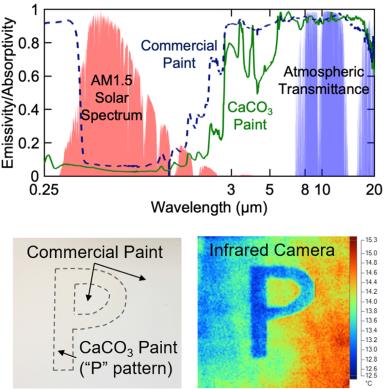 Radiative Cooling (RC) is a cutting-edge, passive cooling
approach for outdoor electronics and buildings. We achieved full
daytime below-ambient radiative cooling in commercial-like
paints for the first time, with an average cooling rate of
>100W/m2. We then expanded this technology and investigated
colored radiative cooling paints, novel concentrated cooling
devices, and two high fidelity case studies of this technology’s
adaptation. The utility of RC paint on transformers was studied
and found a 50% increase in the life expectancy. Using the paint
as a coating for all the exterior surfaces of a typical building, we
predicted a cooling energy savings of >10% with a high-fidelity model that included humidity,
dynamic convective loads, and cloud coverage.
Radiative Cooling (RC) is a cutting-edge, passive cooling
approach for outdoor electronics and buildings. We achieved full
daytime below-ambient radiative cooling in commercial-like
paints for the first time, with an average cooling rate of
>100W/m2. We then expanded this technology and investigated
colored radiative cooling paints, novel concentrated cooling
devices, and two high fidelity case studies of this technology’s
adaptation. The utility of RC paint on transformers was studied
and found a 50% increase in the life expectancy. Using the paint
as a coating for all the exterior surfaces of a typical building, we
predicted a cooling energy savings of >10% with a high-fidelity model that included humidity,
dynamic convective loads, and cloud coverage.
3D Inverse Heat Conduction Method for Microelectronics
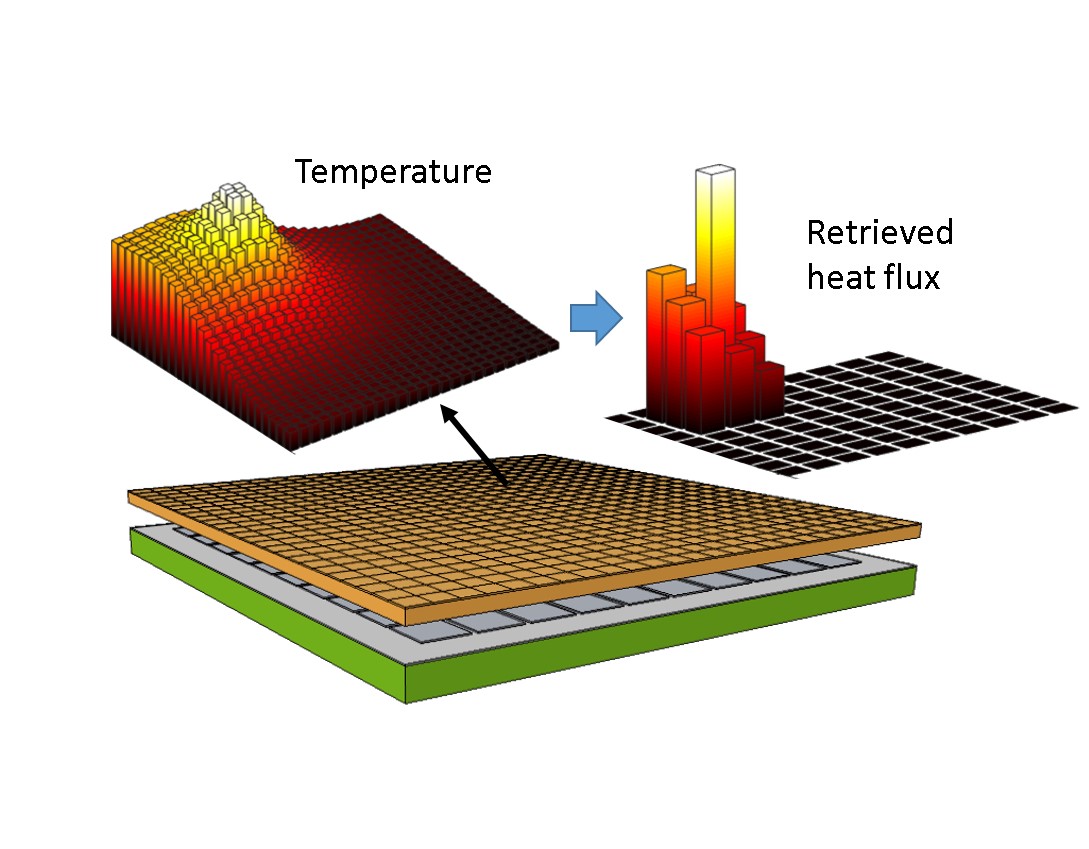 Developed a 3D inverse heat conduction methods to evaluate spatially-varying, transient temperatures and power dissipation maps when direct optical access or instrumentation on the surface of interest is experimentally not feasible. Designed/optimized a discrete sensor placement scheme for use with the inverse heat conduction numerical tool in realistic rack configurations. Two different inverse methodologies were developed and combined with a Kriging interpolation optimization to optimize the number and location of the sensors. The optimization works for any 3D microchip geometry and the methodology can be used for design and active thermal management purposes.
Developed a 3D inverse heat conduction methods to evaluate spatially-varying, transient temperatures and power dissipation maps when direct optical access or instrumentation on the surface of interest is experimentally not feasible. Designed/optimized a discrete sensor placement scheme for use with the inverse heat conduction numerical tool in realistic rack configurations. Two different inverse methodologies were developed and combined with a Kriging interpolation optimization to optimize the number and location of the sensors. The optimization works for any 3D microchip geometry and the methodology can be used for design and active thermal management purposes.
Flexible High Thermal Conductivity Fabrics for Application in Wearable Electronic Devices
 Low-power, wearable electronic devices require methods of attachment to non-flat surfaces, specifically the human form, as well as thermal management techniques to meet ergonomics-driven temperature constraints. Thermally conductive polymer fabrics can potentially serve as the device substrate while simultaneously providing heat spreading functionality. In this project, a high thermal conductivity polymer material is identified, and its thermal properties are characterized in the fiber, yarn and fabric form by developing an IR-microscopy based experimental measurement technique. A complementary reduced-order thermal model is also developed to predict effective fabric thermal conductivity as a function of fiber and weave properties. The project also includes design of bend testing metrologies to assess the mechanical flexibility of the woven fabrics and characterize the effect of bend cycling on their thermal behavior. The developed methods and models can be used to evaluate thermal and mechanical properties of various fabric weave geometries, and help explore the potential design space for applications of these materials as flexible heat spreaders.
Low-power, wearable electronic devices require methods of attachment to non-flat surfaces, specifically the human form, as well as thermal management techniques to meet ergonomics-driven temperature constraints. Thermally conductive polymer fabrics can potentially serve as the device substrate while simultaneously providing heat spreading functionality. In this project, a high thermal conductivity polymer material is identified, and its thermal properties are characterized in the fiber, yarn and fabric form by developing an IR-microscopy based experimental measurement technique. A complementary reduced-order thermal model is also developed to predict effective fabric thermal conductivity as a function of fiber and weave properties. The project also includes design of bend testing metrologies to assess the mechanical flexibility of the woven fabrics and characterize the effect of bend cycling on their thermal behavior. The developed methods and models can be used to evaluate thermal and mechanical properties of various fabric weave geometries, and help explore the potential design space for applications of these materials as flexible heat spreaders.
Multi-Frame Super Resolution Thermal Imaging
Multi-frame super-resolution imaging is a technique that allows for increasing the resolution of any existing optical setup without camera hardware modifications. This technique is particularly relevant and promising for improved thermomechanical characterization and emissivity/temperature mapping using infrared imaging, due to the low native resolution of typical infrared optical systems. This project developed a multi-frame super-resolution infrared imaging algorithm, demonstrated the feature resolution improvement, and quantified the measurement uncertainty. The resolution enhancement enabled new measurement capabilities, such as measurement of strain through digital image correlation, simultaneous with thermography. The technique provides a simple means for users of existing infrared cameras (or other imaging systems) to improve their measurement resolution with little added effort.
Performance of Finned Heat Exchangers and Heat Sinks after Air-Side Fouling and Cleaning
Acoustically Enhanced Heat Transfer
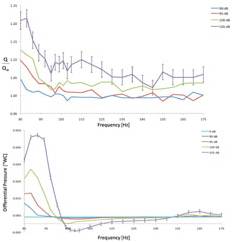 The aim of the project is the enhancement of heat transfer with
an acoustic sound field with, ideally, a smaller pressure drop
in comparison to other surface enhancements. This project
involved experimental investigation of acoustically enhancing
the heat transfer from a fluid flow to the solid wall of a plain
tube and determining the influence of an acoustic field on the
rate of heat transfer. A prototype test stand had been
constructed in which air was the working fluid. The figure plots
dimensionless heat transfer enhancement (Q/Q0)
against the frequency at various sound levels (top) showing that
heat transfer can be enhanced with an acoustic field by up to
30%. Differential pressure inside of the test section plotted
against the frequency (below) shows that with a particular
frequency, the differential pressure is negative.
The aim of the project is the enhancement of heat transfer with
an acoustic sound field with, ideally, a smaller pressure drop
in comparison to other surface enhancements. This project
involved experimental investigation of acoustically enhancing
the heat transfer from a fluid flow to the solid wall of a plain
tube and determining the influence of an acoustic field on the
rate of heat transfer. A prototype test stand had been
constructed in which air was the working fluid. The figure plots
dimensionless heat transfer enhancement (Q/Q0)
against the frequency at various sound levels (top) showing that
heat transfer can be enhanced with an acoustic field by up to
30%. Differential pressure inside of the test section plotted
against the frequency (below) shows that with a particular
frequency, the differential pressure is negative.
Investigation of Nucleate Boiling Mechanisms in Forced Convection Using Laser-Induced Flourescence Thermography
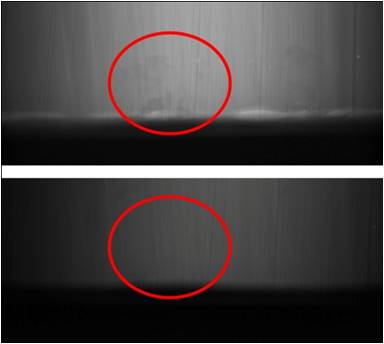 Laser-Induced Fluorescence Thermography (LIFT) is
used to obtain the fluid temperature field around growing and
collapsing vapor bubbles generated during subcooled nucleate
boiling. LIFT relies on the temperature-dependent fluorescence
intensity exhibited by certain dye molecules. Preliminary LIFT
measurements during flow boiling indicate noticeable changes in
fluorescence intensity, which is believed to be the result of a
spatially and temporally-varying temperature field. The figures
show the fluorescence intensity field following a vapor bubble
collapse during subcooled nucleate boiling: a
temperature-sensitive fluorescent dye (upper image) and a
temperature-insensitive fluorescent dye (lower image). The
circled region in both images indicates the region where the
bubble collapsed. Changes in the fluorescence intensity field,
which are apparent in the upper image but not the lower image,
are believed to indicate changes in the liquid temperature
field.
Laser-Induced Fluorescence Thermography (LIFT) is
used to obtain the fluid temperature field around growing and
collapsing vapor bubbles generated during subcooled nucleate
boiling. LIFT relies on the temperature-dependent fluorescence
intensity exhibited by certain dye molecules. Preliminary LIFT
measurements during flow boiling indicate noticeable changes in
fluorescence intensity, which is believed to be the result of a
spatially and temporally-varying temperature field. The figures
show the fluorescence intensity field following a vapor bubble
collapse during subcooled nucleate boiling: a
temperature-sensitive fluorescent dye (upper image) and a
temperature-insensitive fluorescent dye (lower image). The
circled region in both images indicates the region where the
bubble collapsed. Changes in the fluorescence intensity field,
which are apparent in the upper image but not the lower image,
are believed to indicate changes in the liquid temperature
field.
Direct Cooling by Electron Field Emmissions
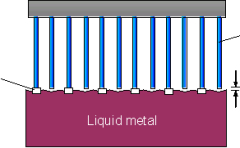 Emission of electrons from a cathode has long
been known to produce a heating or cooling effect at the
emission site depending on the conditions of the emission, such
as the emitter work function and temperature and the applied
electric field. The present concept provides a method by which
an emission gap distance in the nanometer range can be
maintained over areas as large as several square millimeters
using a carbon nanotube array emitter and a liquid metal anode.
Liquid indium and other liquid metals wet carbon nanotubes very
poorly. Because of this characteristic, a narrow gap may be
maintained between a densely packed array of carbon nanotubes
and a liquid metal by placing thin dielectric spacers at
strategic locations between the carbon nanotube-liquid metal
interface (see the accompanying figure). One advantage of this
approach is that the emission gap distance is not affected by
thermal expansion, and another is that the gap distance may be
adjusted by varying the thickness of the dielectric spacers.
Emission of electrons from a cathode has long
been known to produce a heating or cooling effect at the
emission site depending on the conditions of the emission, such
as the emitter work function and temperature and the applied
electric field. The present concept provides a method by which
an emission gap distance in the nanometer range can be
maintained over areas as large as several square millimeters
using a carbon nanotube array emitter and a liquid metal anode.
Liquid indium and other liquid metals wet carbon nanotubes very
poorly. Because of this characteristic, a narrow gap may be
maintained between a densely packed array of carbon nanotubes
and a liquid metal by placing thin dielectric spacers at
strategic locations between the carbon nanotube-liquid metal
interface (see the accompanying figure). One advantage of this
approach is that the emission gap distance is not affected by
thermal expansion, and another is that the gap distance may be
adjusted by varying the thickness of the dielectric spacers.
Electromechanical Transport of Nanofluids: Microfluidic Pumping and Heat Transfer Enhancement
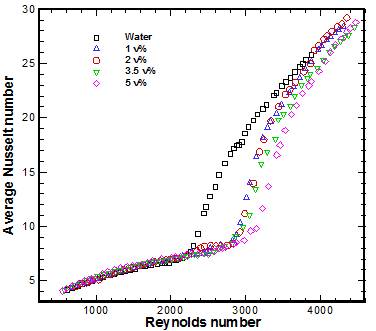 In this work, a thorough investigation was
conducted to study the fundamental mechanisms of single-phase
forced convection of Al2O3-water
nanofluids in a minichannel. Friction factor and convection heat
transfer coefficient were measured for nanofluids of various
volume fractions. Convective heat transfer of nanofluids is
mildly enhanced in the laminar region, however, deteriorates in
the transition and turbulent regions. A novel pumping method was
also developed in this work which exploits dielectrophoresis-induced
particle-fluid interaction to actuate nanofluids without needing
external pumps. With this approach, the flow is generated by
inducing strong electromechanical effects in the fluid using
integrated microelectrodes. The fluidic driving mechanisms due
to the particle-fluid and particle-particle interactions under
twDEP were analyzed and the induced flow field was obtained from
numerical simulations. Experimental measurements of the flow
velocity in a prototype DEP micropumping device show
satisfactory agreement with the numerical predications. The
figure shows a comparison of the average Nusselt number measured
for nanofluids and the base fluid over the entire range of
Reynolds number studied.
In this work, a thorough investigation was
conducted to study the fundamental mechanisms of single-phase
forced convection of Al2O3-water
nanofluids in a minichannel. Friction factor and convection heat
transfer coefficient were measured for nanofluids of various
volume fractions. Convective heat transfer of nanofluids is
mildly enhanced in the laminar region, however, deteriorates in
the transition and turbulent regions. A novel pumping method was
also developed in this work which exploits dielectrophoresis-induced
particle-fluid interaction to actuate nanofluids without needing
external pumps. With this approach, the flow is generated by
inducing strong electromechanical effects in the fluid using
integrated microelectrodes. The fluidic driving mechanisms due
to the particle-fluid and particle-particle interactions under
twDEP were analyzed and the induced flow field was obtained from
numerical simulations. Experimental measurements of the flow
velocity in a prototype DEP micropumping device show
satisfactory agreement with the numerical predications. The
figure shows a comparison of the average Nusselt number measured
for nanofluids and the base fluid over the entire range of
Reynolds number studied.



